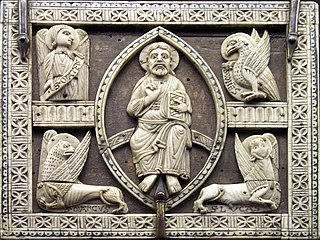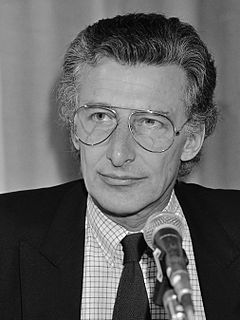
Harry Kurt Victor Mulisch was a Dutch writer. He wrote more than eighty novels, plays, essays, poems, and philosophical reflections. Mulisch's works have been translated into over thirty languages.

Gerard Kornelis van het Reve was a Dutch writer. He started writing as Simon van het Reve and adopted the shorter Gerard Reve[ˈɣeːrɑrt ˈreːvə] in 1973. Together with Willem Frederik Hermans and Harry Mulisch, he is considered one of the "Great Three" of Dutch post-war literature. His 1981 novel De vierde man was the basis for Paul Verhoeven's 1983 film.
Dutch-language literature comprises all writings of literary merit written through the ages in the Dutch language, a language which currently has around 23 million native speakers. Dutch-language literature is the produce of Netherlands, Belgium, Suriname, the Netherlands Antilles and of formerly Dutch-speaking regions, such as French Flanders, South Africa, and Indonesia. The Dutch East Indies, as Indonesia was called under Dutch colonization, spawned a separate subsection in Dutch-language literature. Conversely, Dutch-language literature sometimes was and is produced by people originally from abroad who came to live in Dutch-speaking regions, such as Anne Frank and Kader Abdolah. In its earliest stages, Dutch-language literature is defined as those pieces of literary merit written in one of the Dutch dialects of the Low Countries. Before the 17th century, there was no unified standard language; the dialects that are considered Dutch evolved from Old Frankish. A separate Afrikaans literature started to emerge during the 19th century, and it shares the same literary roots as contemporary Dutch, as Afrikaans evolved from 17th-century Dutch. The term Dutch literature may either indicate in a narrow sense literature from the Netherlands, or alteratively Dutch-language literature.
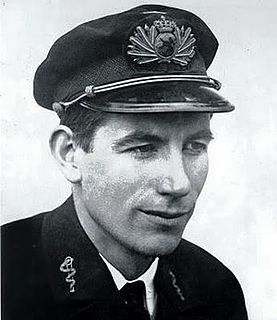
Jan Jacob Slauerhoff, who published as J. Slauerhoff, was a Dutch poet and novelist. He is considered one of the most important Dutch language writers.
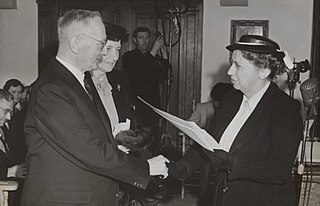
Ferdinand Bordewijk was a Dutch author. His style, which is terse and symbolic, is considered to belong to New Objectivity and magic realism. He was awarded the P. C. Hooftprijs in 1953 and the Constantijn Huygensprijs in 1957. Character (1997), an Academy Award-winning film directed by Mike van Diem, was based on his novel Karakter (1938).
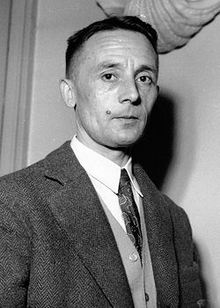
Julien Gracq was a French writer. He wrote novels, critiques, a play, and poetry. His literary works were noted for their dreamlike abstraction, elegant style and refined vocabulary. He was close to the surrealist movement, in particular its leader André Breton.

Hélène "Hella" Serafia Haasse was a Dutch writer, often referred to as "the Grand Old Lady" of Dutch literature, and whose novel Oeroeg (1948) was a staple for generations of Dutch schoolchildren. Her internationally acclaimed magnum opus is "Heren van de Thee", translated to "The Tea Lords". In 1988 Haasse was chosen to interview the Dutch Queen for her 50th birthday after which celebrated Dutch author Adriaan van Dis called Haasse "the Queen among authors".

Menno ter Braak was a Dutch modernist author.
Adriaan Koerbagh was a Dutch scholar and writer who was a critic of religion and conventional morality.
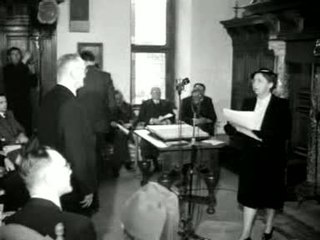
Lambertus Jozef (Bert) Bakker was a Dutch writer and publisher in the Netherlands. He wrote literary studies, two novels, poetry, and children's books. In World War II he was involved in the Dutch Resistance and assisted in the publication of Vrij Nederland. After the war he founded a publishing company under his own name; his nephew, also named Bert Bakker, ran the company until 1993. In 1953 he founded the literary magazine Maatstaf, which he edited until 1969. He was described as a "living legend" in the Dutch publishing industry, having supported and published authors such as Adriaan Roland Holst, Martinus Nijhoff, Gerrit Achterberg, and Neeltje Maria Min.

Adriaan van Dis is a Dutch author. He debuted in 1983 with the novella Nathan Sid. In 1995 his book Indische Duinen, which in its narrative is a follow up to his debut novella, was also awarded several prestigious literary awards.

Wim Verstappen was a Dutch film director and producer, television director, and screen writer.

The Bataviaasch Nieuwsblad was one of the leading and largest daily newspapers in the Dutch East Indies. It was based in Batavia on Java, but read throughout the archipelago. It was founded by the famous Dutch newspaperman and author P. A. Daum in 1885 and existed to 1957.
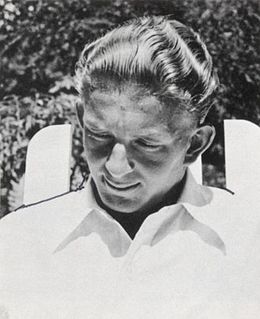
Hans Lodeizen, born Johannes August Frederik Lodeizen, was a Dutch poet. He was the author of one book of poems and a quantity of miscellaneous work. Despite his short life and modest output, his minimalist lyrics, which are generally constituted of short, unrhymed lines without capitals or punctuation, strongly influenced a post-war generation of Dutch poets, including Gerard Reve.

Ellen Jens is a Dutch television director and producer, best known for her collaboration with Wim T. Schippers on VPRO television. She has produced and directed a large number of other television shows, especially on literature and art, and is referred to as a "television legend".
Het spook en de schaduw is a novel by Dutch author Simon Vestdijk. One of the later novels in Vestdijk's career, it was published in 1966 by Nijgh & Van Ditmar. Hella Haasse, in a lengthy analysis in her Lezen achter de letters, calls it a "novel of conscience", and one of his most cynical ones. Agnes Andeweg notes Gothic elements in the novel.

Anton Wachter is the protagonist of eight novels by Dutch author Simon Vestdijk.
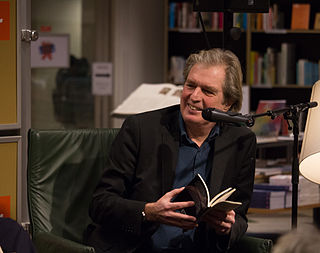
Wim Brands was a Dutch poet, journalist and TV presenter.
A. A. M. Stols was a Dutch printer and publisher, known best for his limited bibliophile editions of Dutch poetry.
Herman Leenders is a Flemish writer and poet.




